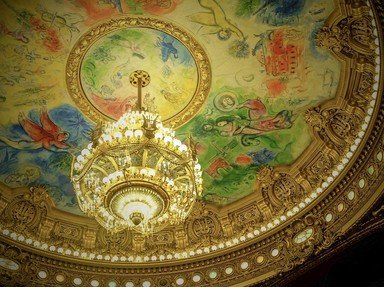Quiz Answer Key and Fun Facts
1. Meyerbeer's "Robert le Diable" features, as its title character, a young man who is the offspring of an illicit relationship between a woman and a demon named Bertram. As such, Robert is half-demon himself, which causes him considerable anguish, particularly since he is in love with the virtuous Isabeau. This opera featured a famous, and quite grotesque ballet featuring which of the following?
2. There have been several operatic (or quasi-operatic) treatments of Goethe's Faust, including Gounod's "Faust", Boito's "Mefistofele", Berlioz's "La Damnation de Faust", and Busoni's "Doktor Faust". Goethe's "Faust" contains a memorable speech, in which Mephistopheles introduces himself thus:
"Ich bin der Geist, der stets verneint!
Und das mit recht; denn alles, was entsteht,
ist wert, dass es zugrunde geht."
"I am the spirit that always negates!
And justifiably so; for everything that exists
deserves to be destroyed."
Which of the following operatic versions of the "Faust" legend contains a version of this speech, in the form of an aria sung by Mephistopheles?
3. During rehearsals for Gounod's "Faust", it was feared that Mephistophele's appearance in one particular scene would cause great offense; why?
4. The Czech opera "The Devil and Kate" affords a rare comical treatment of the "pact with the Devil" theme. Kate is a loquacious village girl whose unending chatter drives away any would-be suitors. When none of the young men at a village fete will dance with her, Kate declares that she would be willing to dance with the Devil himself, if he would have her. A handsome stranger named Marbuel (who is, of course, you-know-who in disguise) appears and, literally, dances her into Hell. Even he, however, grows weary of Kate's constant chatter and he is happy when a shepherd lad named Jirka lures her away. Based on Bohemian folk legend, "The Devil and Kate" is the work of an eminent Czech composer, who also wrote the better-known folktale opera "Rusalka"; who is the composer?
5. Offenbach's operetta "Orphee aux Enfers" features the god Pluto who, as ruler of the Underworld, is the Roman mythological equivalent of Satan. In this comic retelling of the classic Orpheus legend, Eurydice is driven quite mad by her husbands fiddling and is lured voluntarily to the nether-world by Pluto himself. Pluto, taking a page from Jupiter's vast book of tricks, woos Eurydice by disguising himself; what disguise does he adopt?
6. Bedrich Smetana's 1882 opera "The Devil's Wall" concerns the aspirations of the wealthy Vok Vitkovic to find a suitable bride. He eventually is united with the virtuous Hedwika, despite numerous obstacles thrown in his path by the devil Rarach. Rarach is in league with a villager named Benesy, who wants Vok to remain single for reasons of his own. What, ironically, is Benesy's profession?
7. Ferruccio Busoni's 1925 opera "Doktor Faust" is one of the most recent operatic treatments of the Faust legend. The depiction of Mephistopheles in this version is notably different from that of the Gounod, Berlioz, and Boito versions. To begin with, he is portrayed by a tenor (Faust is a baritone, which reverses the usual order); also, he appears in numerous guises throughout the opera. Which of these is NOT a disguise adopted by Mephistopheles in the opera?
8. Douglas Moore's 1939 folk opera "The Devil and Daniel Webster" relates the story of a villager whose soul is lost after he makes a deal with the devil. What is the name of the devil in this opera?
9. In Stravinsky's "The Rake's Progress", the Devil appears in the person of a fellow named Nick Shadow and leads the "rake" of the title (appropriately named Tom Rakewell) to rack and ruin. "The Rake's Progress" was based on a series of paintings of the same name by which of these celebrated English artists?
10. In May of 2003, English composer Richard Thomas premiered an opera at London's National Theatre in which a famous American trash-talk show host is sent to Hell. Which of these is the (literally) damned talk show host?
Source: Author
jouen58
This quiz was reviewed by FunTrivia editor
Bruyere before going online.
Any errors found in FunTrivia content are routinely corrected through our feedback system.
